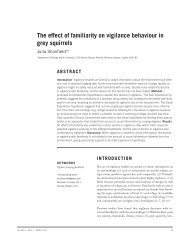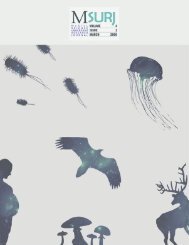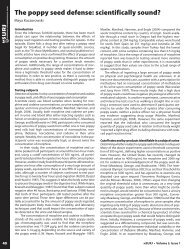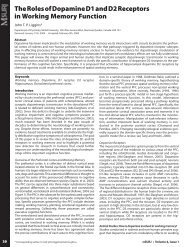the entire issue - McGill Science Undergraduate Research Journal ...
the entire issue - McGill Science Undergraduate Research Journal ...
the entire issue - McGill Science Undergraduate Research Journal ...
Create successful ePaper yourself
Turn your PDF publications into a flip-book with our unique Google optimized e-Paper software.
Selecting for multicellularity in <strong>the</strong> unicellular Alga Chlamydomonas reinhardtii<br />
combinations present in <strong>the</strong> ancestral A2S3 population because <strong>the</strong>se<br />
four had been sexually reproducing since 1992 (17). Errors in crossing<br />
over could also have led to gene duplication and subsequent divergence<br />
of function, or to gene modification. That <strong>the</strong> line emerging<br />
with <strong>the</strong> strongest tendency towards multicellularity was one<br />
of <strong>the</strong>se four previously sexually reproducing is consistent with <strong>the</strong><br />
expectation that genetic diversity increases evolutionary potential<br />
(20). It is unclear, however, why line C1 exhibits such a remarkably<br />
strong and statistically significant response. Agar-base ancestral culture<br />
conditions may have somehow predisposed lines C1 and C2 to<br />
evolving multicellularity.<br />
which managed to be transferred would have proliferated faster. This<br />
would keep <strong>the</strong> frequency of multicellular individuals relatively low.<br />
Ano<strong>the</strong>r possibility is that <strong>the</strong> experiment was too short to allow for<br />
fixation of <strong>the</strong> multicellular phenotype.<br />
Notable Observations<br />
The multicellular response could mean one of three things: 1) cells<br />
have increased <strong>the</strong> duration of cell division or <strong>the</strong> frequency of division,<br />
2) cells are stickier, and tend to cohere, or 3) individuals actually<br />
exist in a paired or multicellular state. To evaluate <strong>the</strong>se three hypo<strong>the</strong>ses,<br />
we monitored division of several cell pairs from one transfer<br />
of line C1—<strong>the</strong> line where selection appeared to be having <strong>the</strong><br />
greatest effect (See Fig. 3). C. reinhardtii typically undergo a number of<br />
cleavages in rapid succession following 6-12 hours of growth (18, 21-<br />
23). The number of cleavages is determined in each cell during interphase<br />
(prior to division) and varies within a population (18, 21-23).<br />
The two pairs shown in Fig. 3 grow or retain a constant volume for at<br />
least five hours while in a paired state before rapid multiple cleavage<br />
occurs over about three hours. If <strong>the</strong> paired cells were actually just<br />
dividing cells, we would not have observed a gap between <strong>the</strong> first<br />
and subsequent cleavages. Fur<strong>the</strong>rmore, <strong>the</strong> cells within a pair are<br />
<strong>the</strong> same size as single cells (not shown). In addition, cultures were<br />
not synchronously dividing. (synchroniziationrequires prolonged<br />
exposure to alternating 12 hour light-dark periods (13)). There is evidence<br />
for asynchronicity in Fig. 3—one pair begins cleavage prior to<br />
17:30, <strong>the</strong> o<strong>the</strong>r begins after 19:20. Within <strong>the</strong> pairs, however, cleavage<br />
is highly synchronized between cells, and each cell gives rise to<br />
<strong>the</strong> same number of daughter cells. In Fig. 3, pair 1 (i-n) undergoes<br />
one more cleavage than pair 2 (a-h). If <strong>the</strong> pairs were simply comprised<br />
of unrelated cells which had stuck toge<strong>the</strong>r, <strong>the</strong>n one would<br />
not expect this intra-pair synchronization. Therefore, <strong>the</strong>se photographs<br />
suggest that both cells within a pair are derived from <strong>the</strong><br />
same mo<strong>the</strong>r cell. Cytoplasmic junctions may be maintained between<br />
members of a pair of daughter cells—a crucial step in <strong>the</strong> evolution of<br />
volvocacean multicellularity (2). Or, if <strong>the</strong> cells are siblings, <strong>the</strong>ir cell<br />
cycles could be inherently synchronized with no need for retaining<br />
cytoplasmic junctions. An alternative possibility is that cells within<br />
a pair are unrelated, but cohered following a collision, and formed<br />
cytoplasmic junctions which allowed for cell cycle synchronization.<br />
That a multicellular phenotype never became fixed in any line is<br />
noteworthy. It has dramatically increased in frequency, but by no<br />
means dominates <strong>the</strong> cultures. Perhaps this is due to a trade-off effect;<br />
cell clumping reduces <strong>the</strong> nutrients available for cells to consume<br />
(15). Centrifugation may have selected for heavier cells at each<br />
transfer, and thus multicellularity, but any single-celled individuals<br />
Fig. 4<br />
Two different cell pairs (a-h, i-n) from line C1 transfer 15 undergoing<br />
division on <strong>the</strong> same agarose plate. At least five hours of growth<br />
Flat Green Aggregates: On three separate occasions, we observed<br />
flat clumps of green cells arranged neatly in an alternating hexagon/pentagon<br />
pattern (particularly Fig. 4.1 a,c,f). These aggregates<br />
were generally circular, although several were irregular. When we attempted<br />
to wash <strong>the</strong>se clumps from <strong>the</strong> haemocytometer and into<br />
a 12 well plate, <strong>the</strong>y proved to be very sticky, often disintegrating<br />
ra<strong>the</strong>r than washing off. Given this observation and that several of<br />
36<br />
<strong>McGill</strong> <strong>Science</strong> <strong>Undergraduate</strong> <strong>Research</strong> <strong>Journal</strong> - msurj.mcgill.ca









